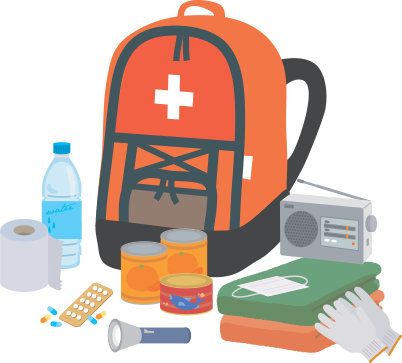What Should You Bring In Your
Car In Case of Disaster?
The items listed below are all important parts of a go bag / disaster supplies kit. Don’t wait to purchase them – prepare today!

Our cars and trucks take us everywhere we want to go. However, there’s a chance those same automobiles may someday take us somewhere we need to go: in the case of a natural disaster, self-evacuation is sometimes the most efficient route to safety. Your automobile needs to be prepared for the possibility of a natural disaster at all times.
Making sure your automobile is prepared requires having a “go bag” complete with particular supplies. We’ve put together a guide discussing odds and ends to have ready in your car in case of natural disasters (including floods, hurricanes, and other emergencies.) Driving away from a natural disaster becomes more difficult when one of the people in the car is elderly. Old age, limited mobility, and the various medical issues associated with becoming elderly can make long car rides more difficult. The goal here is to make sure all parties, including the elderly, complete their car ride in safety.
We focus on which supplies to have on hand in this article and include a longer discussion of how to prepare a car for an elderly passenger.
After a disaster takes place, evacuees sometimes need to survive without power or any other amenities for several days. A “go bag”, or a disaster supplies kit, is a collection of basic survival goods you and your group may need to survive the first few days after an emergency or natural disaster. Most items necessary for a disaster supplies kit are inexpensive and found easily at local stores. In fact, fully prepared kits can be purchased off Amazon.com and other online warehouse stores.
Successful evacuation saves lives – in fact, many of Hurricane Katrina’s casualties were due to New Orleans’ incomplete evacuation of its citizens. More specifically, the final report evaluating Hurricane Katrina’s evacuation failures goes so far as to say the smaller number of casualties suffered in Alabama, Mississippi, and the Louisiana parishes that did evacuate (as opposed to the City of New Orleans and Jefferson Parish) was directly related to the successful implementation of a mandatory evacuation plan placed into action at the earliest possible time. A disaster supplies kit is a critical part of any disaster plan.
The items listed below are all important parts of a go bag / disaster supplies kit. Don’t wait to purchase them – prepare today!

The basic rule is to bring one gallon per day per person for at least three days.
The government suggests bringing at least three days’ worth of non-perishable food. It’s far better to bring non-perishable food than to bring anything that could go rotten as – if a disaster happens – refrigeration will not be available.
Radios are often the only way to communicate and hear news from the outside world after the electricity goes out and the Wi-Fi goes with it. Make sure to have a battery-powered radio as opposed to a plug-in version.
If things go terribly wrong, there may not be enough doctors to treat everyone. Bring your own first aid kit to treat basic wounds, cuts, and abrasions.
If you have pets, do not leave them behind. Bring your pets to a pet-friendly shelter with you or talk to your local veterinarian about options for boarding your pet. If you need to evacuate, your pets do, too.
Pharmacies and most other stores will most likely be closed in the case of a natural disaster or other emergency. Make sure to have a three-day supply of all prescribed medications, if not a larger supply. Your prescription medicines will be near impossible to come by otherwise.
If power lines fall and electricity goes out, you and your group have to rely on battery-powered flashlights.
In the case of a natural disaster or other emergency, make sure your car’s disaster preparedness kit is replete with cash. ATMs and credit card machines will all be unable to function in such an event and your surroundings will immediately become a cash-only economy. Make sure you’re prepared!
Bring enough soap, feminine hygiene products, shampoo, and the like to get you through at least three days.
Make sure to stash all of your important personal documents in a Ziploc sealed bag. Many documents cannot be replaced or at least not easily. Such documents include deeds to homes, passports, and treasured photographs. Additionally, make sure to bring some sort of identification with you when you leave in your car. Having some sort of identification may make it easier to gain entry to shelters and other pivotal checkpoints.
Your car may be your only way out of the disaster zone in an emergency or in a natural disaster. Therefore, make sure your car is in good condition at all times and be certain that you have every thing you need in the car in case of a breakdown. First, let’s discuss what it takes to make sure your car is in good enough condition to drive you away from a natural disaster or emergency.
•Check the car for dents, scratches, and other physical damage every day.
•Check the engine oil once a month.
•Check your vehicle’s tire pressure at least once a month.
•Check the vehicle’s transmission fluid at least once a month.
•Be certain there is always at least half a tank of gasoline in your car at all times. If a natural disaster or emergency hits suddenly, everyone in the vicinity will be attempting to leave the area as quickly as possible. This will mean many drivers on the road, gasoline shortages, and gasoline prices being hiked up. In fact, it’s best you carry an extra gallon of gasoline in your vehicle at all times if even remotely possible.
Additionally, you should include many automobile repair tools and other vehicle-specific items while packing the car to evacuate the disaster area. This is because vehicles are more likely to suffer damage during the storms that tend to happen during natural disasters. This may force drivers to pull over to the side of the road at some point or to even become unable to continue their journey without some vehicular repair. Needless to say, it is imperative that you travel with basic automobile repair tools as you evacuate the disaster area.
A floor jack is a tool designed to lift vehicles so mechanics can get underneath the car in order to make critical repairs. Such a tool could come in handy if a vehicle is badly harmed during an evacuation attempt.
A tow cable or chain links two cars together so one may pull the other, typically after one car has suffered such severe damage it can no longer drive. If there’s a chance your car might suffer damage in the evacuation, you should have one of these on you.
Jumper cables – sometimes referred to as booster cables – are pairs of insulated wires allowing people to connect one car’s dead battery to another car’s living battery, enabling the dead battery to come back to life. This is exactly the type of survival tool one needs to have in their car during an evacuation.
Traction devices can help your car escape getting stuck on any sort of particularly sticky or slippery road. Given that many emergencies requiring evacuation involve bad weather, these devices are definitely a necessary part of your vehicle’s collection of survival tools.
The elderly are in particular danger during natural disasters or other emergencies for several reasons.

Many elderly men and women have limited physical mobility, making it hard for them to travel during an evacuation to the point of having difficulty getting into a car from the door of their home.
The elderly men and women who depend on walkers, wheelchairs, and other accessibility-boosting implements to walk may be unable to climb stairs should elevators stop running.
Many elderly men and women stop driving at a certain point due to their worsening vision. They may not have their own car equipped with all of their needs.
The chronic medical conditions associated with old age sometimes require around-the-clock medical care, making it difficult for the elderly suffering from these illnesses to evacuate.
In order to ameliorate the situation, the elderly need to bring a personalized emergency plan with them into any car aforementioned elderly evacuate. A personalized emergency plan is a document listing all the specific provisions a particular elderly person may need in order to evacuate into a car. The following parts of the personalized emergency plan may take some time to complete, but it’s worth starting now.
Many emergency shelters do not have the amenities that elderly men and women may need to survive. For example, many elderly men and women depend upon around-the-clock medical care in order to live with a given illness. Unfortunately, most shelters are not equipped to handle such needs. Elderly men and women need to find a shelter that can contain him or her before they leave in a car.
Many elderly men and women rely on specific medicines, oxygen tanks, and/or various assistive technologies to help them live comfortable lives. There may not be room in most vehicles for oxygen tanks or other particular assistive technologies. Therefore, it is important to plan ahead that the elderly person in question leaves in a car or truck large enough to hold all medical supplies necessary.
All elderly men and women should travel with a list of emergency contacts such as spouses, children, and grandchildren, medications and medical devices with serial numbers, names and phone numbers of doctors, all placed in a waterproof bag.
Some elderly men and women use service animals to help with particular medical afflictions. As mentioned earlier in this article, in the case of an evacuation all pets also be removed from the evacuation area because pets are unable to fend for themselves during natural disasters or other emergencies. Should an elderly man or woman have to evacuate with a service animal, he or she should bring at least three days’ worth of pet food and of anything else the service animal might need.
It’s also worth noting that many cars and trucks may not be able to accommodate the needs of elderly men and women. For example, many elderly men and women have trouble walking and need to use vehicles that have been modified to be wheelchair-accessible in order to travel. Another issue is that some medical devices elderly men and women may use, such as oxygen tanks, may be too large to fit into most cars and trucks. Those responsible for taking care of elderly men and women should consider these limitations before choosing an evacuation vehicle.
Making sure your car or truck is prepared for a natural disaster or any other type of emergency evacuation is an arduous task, but certainly not impossible by any means. Most items that a given car or truck would need to carry to complete the evacuation journey can be found at a local store or online. In any case, now is the time to start preparations, particularly if you have elderly men or women traveling with you and your group. Disaster preparedness has been demonstrated to save lives: taking the time to put together a go bag, to maintain your vehicle, and to make sure all elderly members of your group have their own personalized emergency plans is something you certainly will not regret.
Here are some informative resources that can further instruct you on how to prepare your car for a natural disaster or emergency:
https://www.ready.gov/build-a-kit
https://www.osha.gov/SLTC/emergencypreparedness/gettingstarted_evacuation.html
https://www.redcross.org/content/dam/redcross/atg/PDF_s/ Preparedness___Disaster_Recovery/Disaster_Preparedness/ Disaster_Preparedness_for_Srs-English.revised_7-09.pdf#_
https://www.fema.gov/news-release/ 2006/05/10/prepare-your-car-evacuation